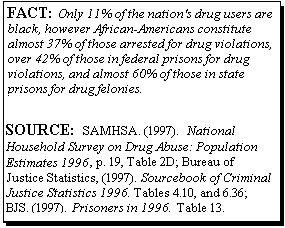
OBJECTIVE: END THE RACIAL BIAS IN DRUG LAWS
 Rationale:
Current laws regarding mandatory minimum sentencing contain documented biases against
minority groups at each stage in the criminal justice process – arrest, prosecution
and sentencing. The negative impacts of these laws have had a devastating effect on black
and Latino populations and must be
changed.
Rationale:
Current laws regarding mandatory minimum sentencing contain documented biases against
minority groups at each stage in the criminal justice process – arrest, prosecution
and sentencing. The negative impacts of these laws have had a devastating effect on black
and Latino populations and must be
changed.
Recommendation 1: End the disparity between crack and powder cocaine sentencing.
83The sentencing disparity between crack and powder cocaine has wreaked havoc on minority communities. First, the powder form of cocaine that is preferred by wealthier, usually white consumers, requires 100 times as much weight to trigger the same penalty as the crack form. These stiff penalties apply to the mere possession of crack, unlike any other drug which requires an intent to distribute.84 As an initial step to address this blatant inequity, the penalties for these two forms of the same drug should be harmonized at the current levels for powder cocaine.
In 1986, before mandatory minimums instituted the crack/powder sentencing disparity, the average sentence for blacks was 6% longer than the average sentence for whites. Four years later following the implementation of this law, the average sentence was 93% higher for blacks.
85 Furthermore, this overly harsh approach encourages drug dealers to enlist young children in their trade in an effort to escape prosecution. The chart above illustrates how blacks and Latinos have been imprisoned disproportionately when compared to other racial groups.Today, one in four black men can expect to be incarcerated in his lifetime.
86This widespread incarceration of black males has increased the burdens on the African-American family unit and the entire community. Our drug laws should not fall disproportionately on one ethnic group. This disparity undermines efforts to stabilize communities and reduce the impact of drug use and abuse.Recommendation 2: Stop targeting black and Latino communities for needle possession arrests.
The policy of denying sterile needles to persons who inject drugs arose a number of years ago, in the pre-HIV/AIDS era. No research has ever shown that making needle possession illegal was effective in reducing drug consumption. But it was effective at making sterile needles scarce and in encouraging persons who injected drugs to share their needles and thus their blood-borne diseases.

Figure 18 The figure above illustrates that Blacks and Hispanics use less drugs, yet have significantly higher rates of incarceration than whites.
Sources: SAMHSA: National Household Survey on Drug Abuse: Population Estimates 1997; Bureau of Justice Statistics (1998). Sourcebook of Criminal Justice Statistics 1997; *Estimates for Hispanics do not include the number of Hispanic men and women in local jails. Data on Hispanic incarceration provided by Bureau of Justice Statistics, (1997).
With the arrival of HIV/AIDS, we had an ineffective policy of drug control (criminalization of sterile needle possession) become a major factor in the spread of a deadly epidemic. In states where mere possession of a syringe is a crime, the person who carries his or her own safe needles risks arrest at all times.
Race is a factor in the problem of inadequate access to clean needles because black and Latino communities have been particularly targeted for drug enforcement efforts. In 1994, there were 166,000 arrests for possession of heroin and cocaine among whites and 153,000 arrests for possession of heroin and cocaine among blacks. Among people who inject drugs, African-Americans are four times as likely as whites to be arrested for possession of heroin and cocaine.
87Since possession arrests for blacks and Latinos are higher, this means that police are more likely to confiscate the personal needles of non-whites. And because the non-white users know (correctly) that they are vulnerable to arrest, the black and Latino drug users are likely to “voluntarily” get rid of their own clean needles to avoid arrest. The end result of these types of policies, is that black and Latino people are nearly five times as likely to contract injection-related HIV, than to die from a drug overdose. Making needles scarce doesn't stop drug use, it simply spreads AIDS. The black and Latino communities are suffering greatly from this counter-productive policy.88
82 H.R. 118, Traffic Stops Statistics Act of 1997, was
introduced by Rep. Conyers (D-MI) on January 7th, 1998.
83 H.R. 2031, Crack-Cocaine Equitable Sentencing Act of 1997,
was introduced by Rep. Rangel (D-NY) and 26 co-sponsors (25 Dems., 1 Ind.) on
June 24th, 1997.
84 U.S. Sentencing Commission. (1995, February). Special Report to
Congress: Cocaine and Federal Sentencing Policy, iii.
85 Meierhoefer, Barbara S. (1992). The General Effect of Mandatory
Minimum Prison Terms: A Longitudinal Study of Federal Offenses Imposed.
Washington, DC: Federal Judical Center.
86 Bonczar, Thomas P. and Allen J. Beck, Ph. D. (1997) Lifetime
Likelihood of Going to State or Federal Prison, Washington, DC: Bureau of
Justice Statistics.
87 Day, Dawn Dr. Health Emergency 1999. (1998). Princeton, NJ:
The Dogwood Center, p. 2.
88 Day, Dawn Dr. Health Emergency 1997. (1996). Princeton, NJ:
The Dogwood Center.